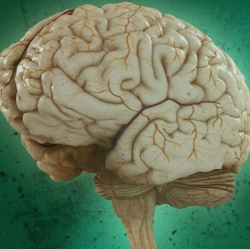
Serotonin is a neurotransmitter that’s partly responsible for feelings of happiness and for mood regulation in humans. This makes it a common target for antidepressants, which block serotonin from being reabsorbed by neurons after it has dispatched its signal, so more of it stays floating around the brain.
Now MIT researchers have developed an imaging technique that, for the first time, enables three-dimensional mapping of serotonin as it’s reabsorbed into neurons, across multiple regions of the living brain. This technique, the researchers say, gives an unprecedented view of serotonin dynamics, and could be a powerful tool for the research and development of antidepressants.
"Until now, it was not possible to look at how neurotransmitters are transported into cells across large regions of the brain," says Aviad Hai, a postdoc in the Department of Biological Engineering and first author of a paper describing the technique in today’s issue of Neuron. "It’s the first time you can see the inhibitors of serotonin reuptake, like antidepressants, working in different parts of the brain, and you can use this information to analyze all sorts of antidepressant drugs, discover new ones, and see how those drugs affect the serotonin system across the brain."
Many antidepressants that target serotonin work by blocking serotonin transporters that reabsorb the neurotransmitter into a neuron, so it can be reused after it has sent a chemical signal. Aptly called "selective serotonin reuptake inhibitors" (SSRIs), these drugs increase levels of serotonin in the brain, alleviating feelings of anxiety and depression caused by low levels of the neurotransmitter.
Researchers most commonly study the effect of antidepressants using a technique known as microdialysis, in which they insert a probe into the brain to take tiny chemical samples from the tissue. But this method is time-consuming and limited in scope, as it allows them to study only a single location at a time.
For the new imaging technique, the researchers engineered a protein to act as a sensor that latches onto serotonin and detaches at the moment of reuptake. The sensor is injected, along with serotonin, and emits a signal that can be read by functional magnetic resonance imaging (fMRI). The trick is that the sensor remains off, emitting a low signal — when bound to serotonin, and turns on — creating a much brighter signal, when serotonin is removed.
In the new system, a mathematical model uses the fMRI signal data to construct a 3-D map that consists of more than 1,000 voxels (pixels in three dimensions), with each voxel representing a single point of measurement of serotonin reuptake. Based on the signal strength at each point, the model calculates the amount of serotonin that gets absorbed, in the presence and absence of SSRIs.
"Basically, what we’ve seen in this work is a method for measuring how much of a neurotransmitter is being [absorbed], and how that amount, or rate, is affected by different drugs … in a highly parallel fashion across much of the brain," Jasanoff says. That information could be very valuable for testing drug efficacy, he says.
Next steps for the researchers are to explore different regions of the brain with this sensor, including the dorsal raphe, which produces most of the brain’s serotonin. They’re also making another nanoparticle-based sensor that is more sensitive than one used for this study.
